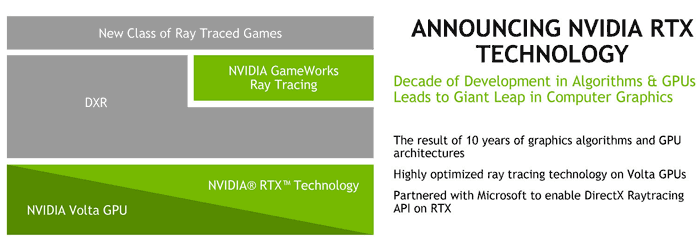Today at the Game Developers Conference 2018 (GDC 2018), Microsoft took the wraps off its hardware accelerated DirectX Raytracing API, or DXR for short. Many computer users will have at least heard of Raytracing. It is a computationally intensive process that generates a visual scene from any angle by considering how light would react to the shapes and materials within that scene. It is a rendering technique used extensively in the film and animation industry but the processing demands have been too high for any real-time gaming, for instance, which demands high frame rate performance. Interestingly, one of the presentation DXR slides teases that Raytracing has been "too demanding for real-time… until now".
PC games traditionally use a different method for visualising the 3D scenes gamers adventure, explore, and battle around. Rasterisation techniques are much faster to accomplish on the GPU architectures we have now. With this 3D image rendering method, scenes are built from polygon meshes with colour and texture data which is then converted to pixels on the 2D monitor. Rasterisation techniques have progressed well over recent years adding more lifelike qualities thanks to pixel processing, shading and lighting algorithms. However, Raytracing is still superior and the choice of pro graphics users such as architects, industrial designers, animators and engineers.
At GDC 2018 we learned that Microsoft DXR will be supported by engines such as Unreal, Unity, Frostbite, and Allegorithmic, and developers including EA, Remedy and 4A games are already working on DXR projects. We are promised "a new class of ray traced games," as the result.

Nvidia RTX
To work alongside Microsoft's DirectX Raytracing API, Nvidia has introduced RTX. It claims that the technology. 10 years in the making, "brings real-time, move quality rendering to game developers". For now it sounds like a future tech for enthusiasts and gamers, as it will be a highly optimised technology "on Nvidia Volta GPUs". Nevertheless Nvidia promises that the tech will lead to a "giant leap in computer graphics".
Raytracing techniques that create area shadows, glossy reflections, and ambient occlusion are now available to developers thanks to Raytracing for GameWorks. This software is in early access for now but general availability is "coming soon". Already Nvidia has some glowing testimonials to share. Remedy Entertainment's technology team manager Miko Orrenmaa, said that developing on Nvidia RTX, enabled the team to "prototype new lighting, reflection, and ambient occlusion techniques, with significantly better visual fidelity than traditional rasterisation techniques."
AMD collaboration
HEXUS received an email bulletin from AMD about its own work on Microsoft's DirectX Raytracing API. It said that it was "closely collaborating with Microsoft," on the future of the API. More specifically it is helping to "define, refine and support the future of DirectX12 and ray tracing". Without mentioning any of its own hardware/software technologies, AMD said that it "remains at the forefront of new programming model and application programming interface (API) innovation based on a forward-looking, system-level foundation for graphics programming." AMD hinted that it would have more to share about PC-based ray tracing techniques in the future.
AMD is announcing Radeon ProRender support for real-time GPU acceleration of ray tracing techniques mixed with traditional rasterization based rendering. Interestingly, this new process fuses the speed of rasterization with the physically-based realism that users of Radeon ProRender expect for their workflows.







